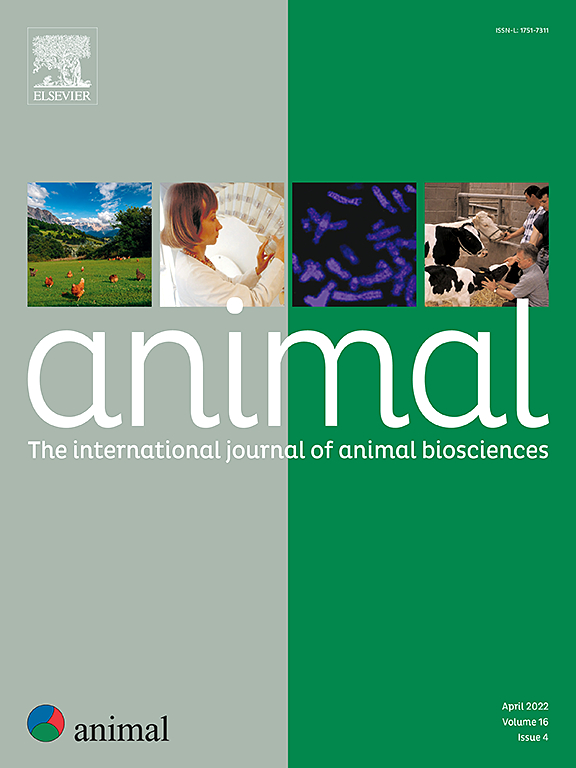Biogenic and fossil main greenhouse gas emissions of dairy, beef, pig and poultry systems
IF 4.2
2区 农林科学
Q1 AGRICULTURE, DAIRY & ANIMAL SCIENCE
引用次数: 0
Abstract
Conventional analyses of the carbon footprint of livestock systems do not consider the relationships between the characteristics and sources of each greenhouse gas (GHGs; CH4, N2O, CO2) and the different livestock systems. This study aimed to assess the carbon footprint of a variety of livestock systems, including different animal categories (dairy cattle, beef cattle, pig and poultry) and production circumstances (lowland and mountain areas). An attributional cradle-to-gate-of-the-farm Life Cycle Assessment was used, considering the emission pattern of each GHG and distinguishing fossil and biogenic origins. The production stages included animal and manure management, on– and off-farm feed production and the production and use of the farm materials. The functional unit was 1 kg of crude protein in animal food (CPAF). Emissions per single GHG and production stage were analysed with a general linear model which included the effect of the livestock system, which proved to significantly influence the emission pattern of all GHGs, both in absolute terms (kg/kg CPAF) and with respect to the single production stage. The CO2 (fossil-based) resulted as the most emitted GHG (10.2–27.6 kg/kg CPAF), 10–255 and 284–646 times greater than CH4 and N2O, respectively. Methane was found to be more associated with the animal category (ruminants), whereas N2O and CO2 were more associated with the input intensity level. Livestock systems strongly influenced the biogenic GHG emissions but not the fossil-related one, with dairy, pig and poultry systems showing similar and lower values than beef. In conclusion, the evaluation of the pattern of each GHG as well as of their biogenic or fossil origin can give indications to address the reduction of global warming.
乳制品、牛肉、猪和家禽系统的生物源性和化石性主要温室气体排放
传统的牲畜系统碳足迹分析没有考虑每种温室气体的特征和来源之间的关系;CH4, N2O, CO2)和不同的牲畜系统。本研究旨在评估各种牲畜系统的碳足迹,包括不同动物类别(奶牛、肉牛、猪和家禽)和生产环境(低地和山区)。考虑到每种温室气体的排放模式,并区分化石和生物成因,采用归因的“从摇篮到农场大门”生命周期评估。生产阶段包括动物和粪便管理、场内和场外饲料生产以及农场材料的生产和使用。功能单位为1 kg动物性食品粗蛋白质(CPAF)。采用一般线性模型分析了单个温室气体和生产阶段的排放量,其中包括牲畜系统的影响,证明畜牧业对所有温室气体的排放模式都有显著影响,无论是绝对数量(kg/kg CPAF)还是相对于单个生产阶段。二氧化碳(化石基)是排放最多的温室气体(10.2-27.6 kg/kg CPAF),分别是CH4和N2O的10-255倍和284-646倍。甲烷与动物类别(反刍动物)的关系更为密切,而N2O和CO2与投入强度水平的关系更为密切。牲畜系统对生物源性温室气体排放有强烈影响,但对化石相关的温室气体排放没有影响,乳制品、猪和家禽系统的排放量与牛肉相似,且低于牛肉。总之,对每种温室气体的模式及其生物源或化石源的评估可以为解决全球变暖问题提供指示。
本文章由计算机程序翻译,如有差异,请以英文原文为准。
求助全文
约1分钟内获得全文
求助全文
来源期刊

Animal
农林科学-奶制品与动物科学
CiteScore
7.50
自引率
2.80%
发文量
246
审稿时长
3 months
期刊介绍:
Editorial board
animal attracts the best research in animal biology and animal systems from across the spectrum of the agricultural, biomedical, and environmental sciences. It is the central element in an exciting collaboration between the British Society of Animal Science (BSAS), Institut National de la Recherche Agronomique (INRA) and the European Federation of Animal Science (EAAP) and represents a merging of three scientific journals: Animal Science; Animal Research; Reproduction, Nutrition, Development. animal publishes original cutting-edge research, ''hot'' topics and horizon-scanning reviews on animal-related aspects of the life sciences at the molecular, cellular, organ, whole animal and production system levels. The main subject areas include: breeding and genetics; nutrition; physiology and functional biology of systems; behaviour, health and welfare; farming systems, environmental impact and climate change; product quality, human health and well-being. Animal models and papers dealing with the integration of research between these topics and their impact on the environment and people are particularly welcome.
 求助内容:
求助内容: 应助结果提醒方式:
应助结果提醒方式:


